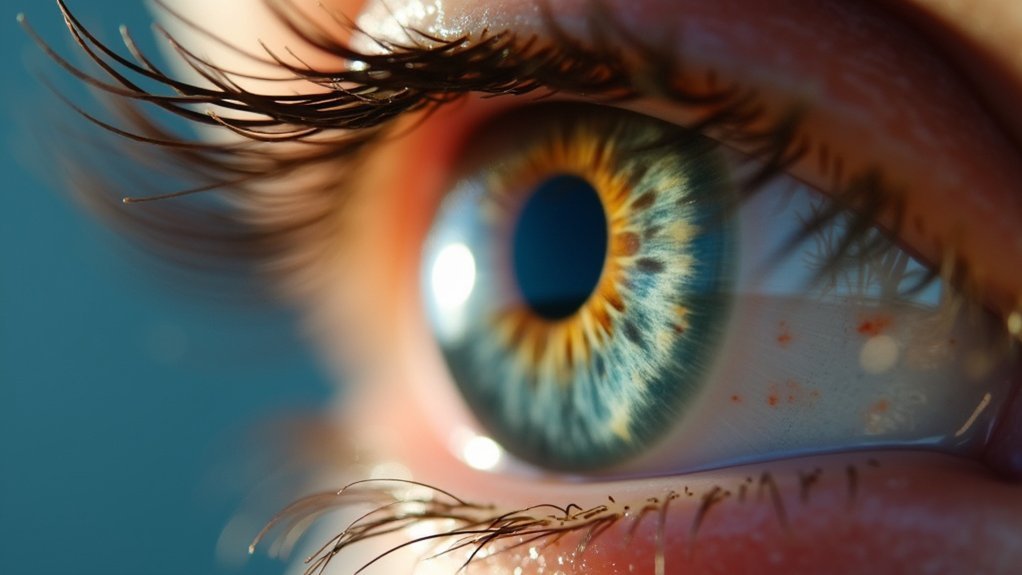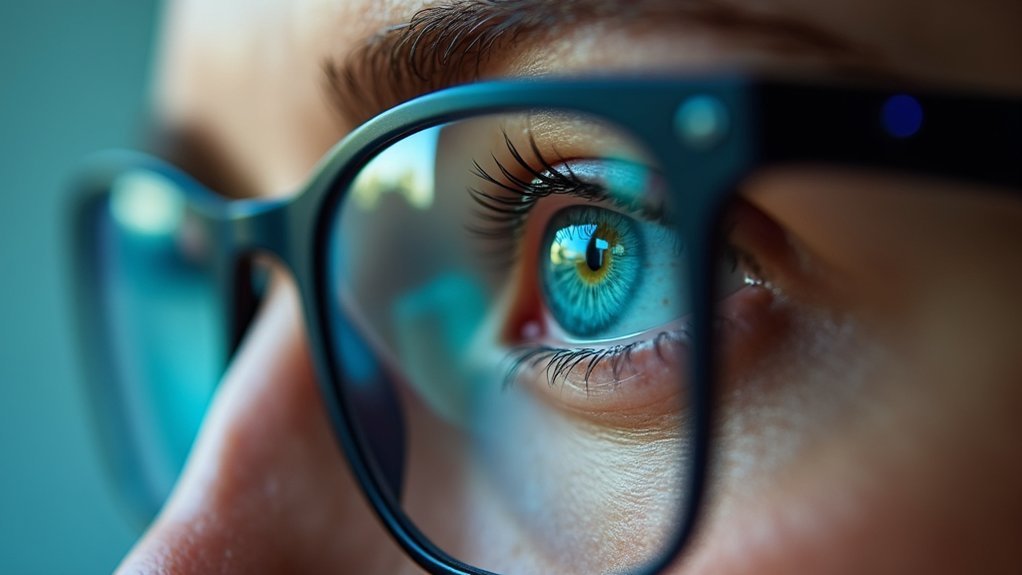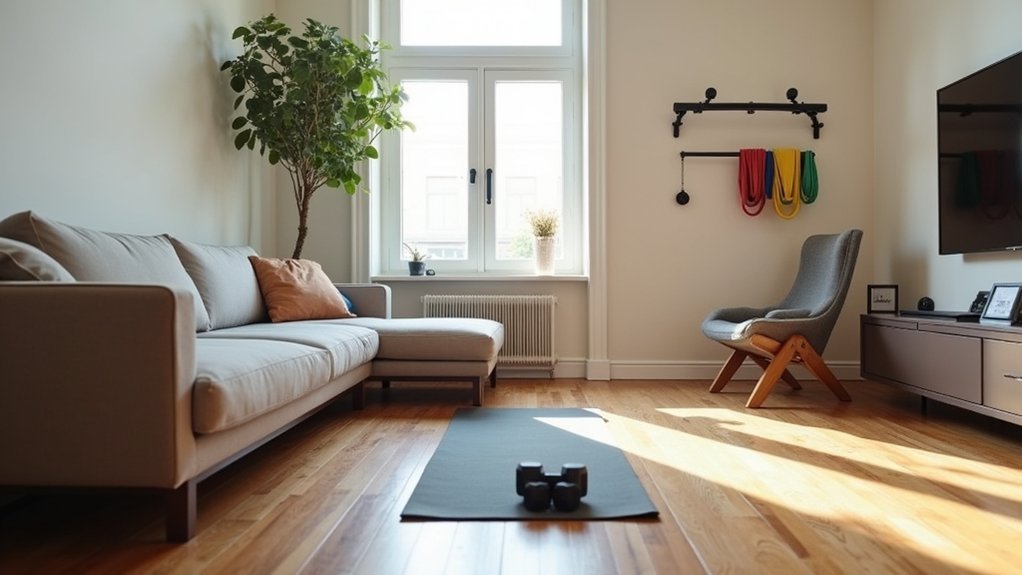You can improve pupil detection precision by implementing systematic algorithm selection from proven methods and using robust calibration techniques like spiral motion patterns. Address real-time processing challenges with enhanced lighting systems and dynamic adaptation to changing conditions. Apply Canny edge filtering with morphological operations to reduce artifacts, while leveraging machine learning approaches for adaptive tracking that adjusts to your specific environment. Optimize camera placement and use high-resolution sensors with distortion correction for maximum accuracy and reliability throughout your sessions.
Algorithm Selection Framework for VR Eye Tracking Systems
When you’re developing VR eye tracking systems, selecting the right pupil detection algorithm can make or break your project’s success. The algorithm selection framework addresses this challenge by systematically comparing 13 state-of-the-art pupil detection algorithms through a unified interface.
You’ll find this framework guides you through reproducible performance evaluation workflows, ensuring you can assess detection quality across varying conditions specific to virtual environments.
This systematic approach is essential because poor pupil detection directly impacts data quality and can lead to misinterpretation of user behavior. By validating algorithms on retrospective data, you’re empowered to make informed decisions that elevate your eye-tracking technology standards.
The framework’s focus on VR-specific challenges ultimately improves detection precision and fosters broader consumer acceptance.
Challenges of Dust and Contamination in VR Headset Environments
Although selecting the right algorithm forms the foundation of effective pupil detection, real-world VR environments present additional obstacles that can undermine even the most sophisticated systems. Dust and contamination on your headset’s lenses create significant performance challenges for eye tracking accuracy. Even tiny particles can disrupt algorithms, causing tracking loss and reducing user satisfaction.
| Contamination Impact | Detection Consequences |
|---|---|
| Lens dust particles | Algorithm disruption |
| Dirt accumulation | Tracking errors |
| Smudged surfaces | Calibration issues |
| Environmental debris | Fixation identification loss |
| Protective wear absence | System performance decline |
You’ll need regular cleaning protocols and protective covers to maintain peak functionality. Advanced camera technology and improved algorithms are addressing these contamination challenges, but prevention remains your best strategy for consistent pupil detection precision in uncontrolled environments.
Edge Detection Methods for Enhanced Pupil Recognition

Beyond preventing contamination through protective measures, implementing robust edge detection methods offers a powerful solution for maintaining pupil recognition accuracy even when environmental factors compromise image quality.
You’ll find that effective pupil detection algorithms rely on sophisticated edge-based methods to overcome common tracking challenges:
- Canny edge filtering with morphological operations – The ElSe algorithm combines these techniques for superior noise filtering and enhanced detection performance.
- Preprocessing through opening operations – This approach removes minor artifacts before edge extraction begins.
- Illumination adaptation – Your system must adjust to varying illumination conditions that affect pupil edges visibility.
- Dust particle mitigation – Algorithms can distinguish between actual pupil boundaries and interference from dust particles.
- Trade-off optimization – Balancing sensitivity prevents tracking errors while maintaining accurate edge detection.
Morphological Operations in Real-Time VR Applications
When you’re implementing morphological operations in VR systems, you’ll face significant real-time processing challenges that demand efficient algorithms capable of handling high-frequency eye movements and variable lighting conditions.
You can optimize edge detection specifically for VR environments by combining morphological techniques with methods like Canny filtering, which helps isolate pupil boundaries from surrounding noise and optical contaminants.
You’ll need to fine-tune morphological filters through strategic parameter adjustment to achieve the sub-1 degree accuracy required for precise gaze tracking without compromising processing speed.
Real-Time Processing Challenges
Processing pupil detection data in real-time VR applications demands sophisticated morphological operations that can adapt to rapidly changing conditions while maintaining exceptional speed and accuracy.
You’ll face significant challenges balancing computational efficiency with detection accuracy as illumination conditions fluctuate throughout your VR session.
Real-time processing constraints create these critical challenges:
- Performance bottlenecks – Your pupil detection algorithms must process frames fast enough to prevent noticeable lag in eye tracking.
- Dynamic lighting adaptation – Morphological operations need constant adjustment as illumination conditions change during gameplay.
- Obstruction handling – Dust particles on lenses require robust filtering without compromising processing speed.
- Memory optimization – Limited computational resources demand efficient algorithm implementations.
- Latency minimization – Every millisecond counts for seamless user interaction and immersion.
VR Edge Detection
Edge detection algorithms in VR environments require morphological operations that can distinguish subtle pupil boundaries from complex iris patterns while maintaining the microsecond precision your headset demands. You’ll find that morphological operations enhance edge detection accuracy by refining shapes and structures within dynamic environments. The ElSe algorithm combines these techniques with edge filters, effectively isolating pupils from surrounding features to boost detection rates during real-time processing.
| Challenge | Solution |
|---|---|
| Lighting variations | Adaptive morphological operations |
| Dust particles on lenses | Noise reduction algorithms |
| Complex iris patterns | Enhanced edge detection filters |
| Motion blur | Dynamic threshold adjustments |
| User engagement loss | Precise pupil localization |
When you integrate morphological operations with advanced edge detection methods like Canny, you’ll achieve improved pupil localization that’s essential for maintaining seamless user engagement in your VR experience.
Morphological Filter Optimization
Although morphological operations like dilation and erosion form the backbone of effective pupil detection, you’ll need to optimize these filters specifically for real-time VR constraints where processing delays can’t exceed critical timing thresholds.
The ElSe algorithm demonstrates how morphological filtering techniques can enhance pupil edges while maintaining real-time performance.
Your optimization strategy should focus on:
- Noise reduction – Remove small dust particles that interfere with pupil detection algorithms
- Enhanced contour definition – Strengthen pupil boundaries for clearer edge detection
- Efficient processing – Balance filtering quality with computational speed requirements
- Dynamic adaptation – Adjust morphological operations based on varying lighting conditions
- Smooth integration – Guarantee seamless operation within existing eye-tracking systems
Proper morphological filter optimization delivers significant accuracy improvements, making your eye-tracking system more reliable in demanding VR environments.
Calibration Techniques for Immersive Virtual Reality Experiences
You’ll need robust VR gaze calibration methods to achieve the precision required for seamless virtual reality interactions.
Your tracking accuracy depends on whether you implement 2D detection for sub-degree precision or 3D methods that typically range between 1.5 to 2.5 degrees of accuracy.
The calibration technique you choose—whether single marker spiral motion or natural features sampling—directly impacts how well your system maps eye movements to virtual coordinates.
VR Gaze Calibration Methods
When implementing gaze tracking in virtual reality environments, you’ll need calibration methods that account for the unique challenges of headset-mounted displays and three-dimensional interactions.
VR systems employ sophisticated pupil detection algorithms combined with both 2D and 3D detection techniques to enhance accuracy during immersive experiences.
- Standard calibration markers like Pupil Calibration Markers enable automatic detection and improve precision for fixation locations.
- Single Marker Calibration requires gazing at center points while performing spiral motions for thorough coverage.
- Natural Features Calibration samples environmental points throughout your entire field of view automatically.
- 2D gaze mapping achieves sub 1-degree accuracy while 3D gaze mapping reaches 1.5-2.5 degrees precision.
- Accuracy Visualizer plugins calculate angular offset between calibrated and actual gaze mapping accuracy measurements.
Immersive Tracking Accuracy
Since VR environments present unique spatial challenges that traditional 2D calibration can’t fully address, immersive tracking accuracy demands specialized techniques that account for depth perception and three-dimensional object interaction.
You’ll achieve ideal eye tracking performance by implementing both 2D and 3D pupil detection methods. While 2D calibration delivers sub-1 degree visual degrees accuracy, 3D mapping provides 1.5 to 2.5 degrees precision for depth-based interactions.
You should utilize the v0.4 calibration markers with spiral motion patterns to cover your entire field of view effectively.
Regular recalibration becomes essential as environmental changes and head movements can compromise tracking precision. The Accuracy Visualizer plugin helps you monitor calibration accuracy by calculating angular offset between fixation points, ensuring consistent immersive tracking performance throughout your VR experience.
Impact of Illumination Variations on Detection Performance
Although modern eye-tracking systems have achieved remarkable accuracy in controlled environments, illumination variations pose one of the most persistent challenges to maintaining consistent pupil detection performance.
When you’re dealing with changing light conditions, your system’s tracking accuracy can deteriorate rapidly, affecting the quality of eye-tracking data.
Here’s how illumination variations impact your detection performance:
- Reduced pupil visibility under low-light conditions decreases algorithm reliability
- Reflections on eyeglasses create noise that confuses detection algorithms
- Inconsistent lighting forces pupil detection algorithms to constantly readjust parameters
- Environmental light changes introduce artifacts that compromise data quality
- Poor illumination control limits effectiveness in real-world applications
You’ll need adaptive algorithms and high-quality lighting techniques to maintain robust performance across varying illumination conditions.
Machine Learning Approaches for Adaptive Pupil Tracking
As illumination challenges continue to plague traditional pupil detection methods, machine learning approaches offer a transformative solution that adapts dynamically to changing conditions. You’ll find that CNNs excel at pupil detection algorithms by learning from vast datasets, enabling superior performance across varying illumination conditions and environments where eyeglass wearers previously struggled.
| Feature | Traditional Methods | ML-Based Approaches |
|---|---|---|
| Adaptability | Fixed thresholds | Dynamic adjustment |
| Accuracy | Poor in variable light | Robust performance |
| Training Data | Manual calibration | Automated learning |
These adaptive pupil tracking systems leverage real-time data processing and transfer learning techniques, reducing labeled data requirements while enhancing detection confidence. The integration notably improves user satisfaction and eye-tracking technology acceptance among diverse user populations.
Hardware Optimization Strategies for VR Eye Tracking Devices
While machine learning algorithms provide the computational foundation for adaptive pupil tracking, the physical hardware components within VR headsets determine the quality of data these algorithms can process.
To maximize pupil detection accuracy in VR eye tracking systems, you’ll need to focus on these critical hardware optimization strategies:
Hardware optimization forms the cornerstone of accurate VR eye tracking, requiring careful attention to camera positioning, lighting, and sensor quality.
- Optimize camera placement and angle to guarantee clear sight lines to your eyes while minimizing obstructions from the headset frame.
- Implement advanced illumination techniques like infrared lighting to maintain consistent pupil visibility across varying environmental conditions.
- Establish robust calibration protocols specifically designed for VR optics to compensate for headset-induced distortions.
- Upgrade to higher resolution sensors for enhanced pupil image clarity and improved tracking performance.
- Maintain optical components regularly by cleaning lenses to prevent dust and dirt accumulation that degrades detection precision.
Quality Assessment Metrics for Virtual Reality Gaze Data
Precision emerges as the cornerstone metric when evaluating VR gaze tracking performance, directly impacting how effectively users can interact with virtual environments.
You’ll need to assess multiple quality assessment metrics to guarantee your pupil detection algorithms deliver reliable results. Angular offset and gaze position error quantify discrepancies between actual targets and detected gaze points, with sub-1-degree accuracy being ideal.
Robustness becomes critical when facing changing illumination conditions and other environmental factors that can degrade tracking performance.
You can visualize tracking effectiveness through gaze heatmaps, which reveal attention distribution patterns across virtual elements.
Implementing thorough assessment protocols guarantees consistent performance despite varying conditions, maintaining the immersive experience users expect from VR systems.
Artifact Reduction Methods in High-Resolution VR Displays
When you’re working with high-resolution VR displays, you’ll need to tackle three critical areas to reduce artifacts that compromise pupil detection accuracy.
You must focus on minimizing display noise that creates visual interference, correcting optical distortions inherent in VR lens systems, and implementing resolution enhancement techniques that sharpen pupil boundaries.
These methods work together to create cleaner visual conditions that enable your eye-tracking algorithms to identify and track pupils with greater precision.
Display Noise Minimization
Several factors contribute to display noise in high-resolution VR environments, creating significant challenges for accurate pupil detection.
You’ll find that these visual disturbances can severely compromise gaze tracking accuracy, especially in dynamic environments where rapid scene changes amplify the problem.
To effectively minimize display noise and preserve pupil features, you should implement these targeted strategies:
- Apply temporal averaging and spatial filtering to smooth rapid fluctuations while maintaining pupil clarity
- Utilize advanced anti-aliasing techniques to eliminate jagged edges that interfere with detection algorithms
- Implement adaptive contrast enhancements to improve pupil visibility against varying backgrounds
- Perform regular calibration adjustments to maintain peak tracking performance
- Invest in high-quality lenses that reduce inherent display artifacts
These artifact reduction methods work synergistically to create cleaner visual environments for more precise pupil detection.
Optical Distortion Correction
As high-resolution VR displays introduce complex optical distortion corrections through their lens systems, you’ll need strong correction algorithms to maintain accurate pupil detection precision.
Advanced algorithms employing radial and fisheye distortion models effectively map eye movements by accounting for your camera’s field of view variations. The calibration process requires capturing multiple patterns to estimate camera intrinsics, enabling real-time adjustments during active use.
You’ll find that artifact reduction methods greatly minimize visual obstructions from lens imperfections, enhancing eye image clarity. Regular algorithm refinements guarantee adaptation to evolving display technologies and varying user environments.
These thorough optical distortion correction approaches work together to deliver reliable eye-tracking data, making your VR experience more responsive and accurate.
Resolution Enhancement Techniques
While optical distortion correction establishes the foundation for accurate eye tracking, resolution enhancement techniques take pupil detection precision to the next level by dramatically reducing visual artifacts that plague high-resolution VR displays.
You’ll benefit from several key artifact reduction methods:
- Advanced filtering techniques minimize visual noise that interferes with pupil detection algorithms
- High-resolution sensors capture subtle eye movements with enhanced tracking accuracy and reliability
- Real-time data processing enables algorithms to adapt dynamically to varying illumination conditions
- Machine learning models identify and compensate for artifacts in high-resolution images automatically
- Enhanced lighting systems improve pupil visibility despite optical obstructions like dust and dirt on lenses
These techniques work together to deliver cleaner, more precise data, ensuring your VR experience remains immersive and responsive.
Frequently Asked Questions
Can Eye Tracking Be Improved?
You can improve eye tracking by implementing advanced algorithms that handle environmental contaminants, using higher resolution sensors with machine learning adaptation, maintaining regular device cleaning, and applying precise calibration techniques.
What Is Accuracy and Precision of Eye Tracking?
You’ll find accuracy measures how close your tracked gaze aligns with actual looking points, while precision indicates consistency across repeated measurements. High-quality systems achieve sub-1-degree accuracy with reliable precision.
What Are Two Key Measures for Eye Tracking?
You’ll find accuracy and precision are eye tracking’s two key measures. Accuracy shows how close your measured gaze points match actual targets, while precision indicates how consistently you’re capturing repeated measurements.
How Do You Train Eye Tracking?
You’ll start with calibration by gazing at specific markers to establish baseline accuracy. Then you’ll practice structured gaze patterns like spirals while algorithms learn from your eye movements to improve detection precision.
In Summary
You’ve now explored thorough strategies for enhancing pupil detection precision in VR eye tracking systems. You’ll need to integrate algorithm selection frameworks with robust edge detection methods while accounting for environmental challenges like dust contamination. Don’t overlook the importance of morphological operations and machine learning adaptability. You’ll achieve ideal results by combining hardware optimization with quality assessment metrics and implementing effective artifact reduction techniques for your immersive VR experiences.





Leave a Reply